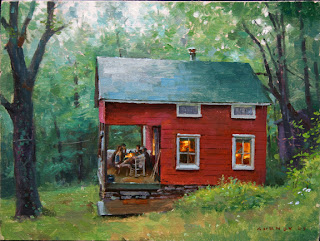Color and Light
Sources of Light - Chapter 2
Direct Sunlight
Three different systems of illumination:
1. The sun
2. The blue sky
3. Reflected light from illuminated objects
The second sources should be treated as secondary to the sun itself.
Different planes of an object facing different sources will react differently.
Overcast Light
Soft illumination of objects as sunlight is diffused through clouds.
Allows for more accurate colors and shapes without much contrast from sunlight and shadows.
Window Light
Generally, the light coming from outside through a window will contrast the light source inside. On a sunny day, warm light coming from outside contrasts with cool light inside. On a cloudy day, cool light coming from outside contrasts with warm light inside.
Candlelight and Firelight
Yellow-orange in color and fairly weak - dropping off rapidly as objects recede from the flame.

Indoor Electric Light
Keep in mind three qualities of indoor lighting:
1. Relative brightness
2. Hardness or softness
3. Color cast
Keep in mind the relation of all three within a scene.

Streetlights and Night Conditions
Before electric lights, night scenes were strictly limited to moonlight and lamp light. Lamp light is weak. The two light sources contrasted each other often.
The goal of night painting should be to show what the eye would be seeing rather than a camera.
Helpful tip for studying nocturne painting:
- Plein air paint night scenes with a portable LED light to illuminate your palette and canvas.

Luminescence
Things giving off a glow at cool temperatures.
- Bioluminescence: living things such as fish, jellyfish, and algae give off light.
- Flourescence: objects converting invisible electromagnetic energy to visible wavelength.
Tip:
- Paint the scene first in darker tones and then add the glowing effects last.
Hidden Light Sources
Three ways to light a scene:
1. From a source outside the picture.
2. From a light inside the picture you can easily see.
3. From a light inside the scene that's concealed from view.
Hidden light is mysterious and often invites the viewer to want more...
It can help define silhouette.

100 Tuesday Tips
Stylizing an Object
J.C. Leyendecker would stylize heavily. He would only do his final sketch from the studies he did.
Steps:
1. Set up a model/still life/etc.
1. Set up a model/still life/etc.
2. Do a study of it.
- Edit, stylize, change angle/perspective/size... etc.
- PUSH the shape. (Make things round to be rounder, tall to be taller, short to be shorter, thin to be thinner... etc.
3. Only do your final sketch from your study.
Make sure it "feels" the same.
Making a Series from one Painting
1. Make thumbnails from original painting.
2. Pick 2 thumbnails.
3. See how all three look together.
4. Make color comps using the same limited palette.
5. Pick a color comp series and finish them.
No comments:
Post a Comment